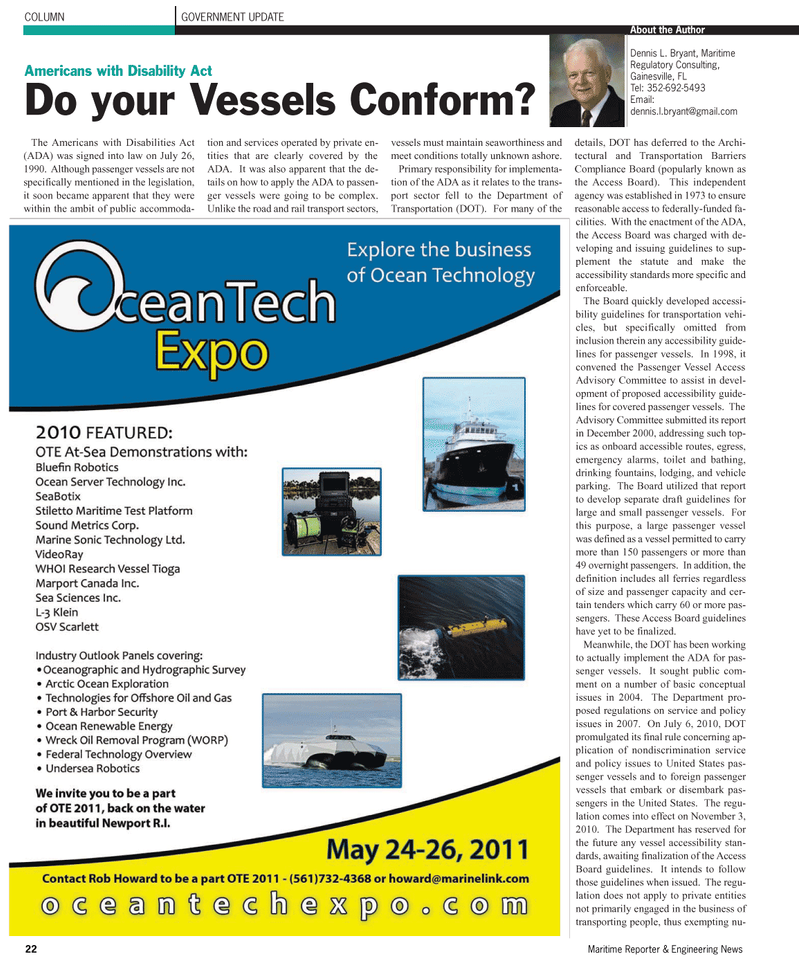
Page 22: of Maritime Reporter Magazine (August 2010)
The Electric Ship
Read this page in Pdf, Flash or Html5 edition of August 2010 Maritime Reporter Magazine
The Americans with Disabilities Act (ADA) was signed into law on July 26, 1990. Although passenger vessels are not specifically mentioned in the legislation, it soon became apparent that they were within the ambit of public accommoda- tion and services operated by private en- tities that are clearly covered by the
ADA. It was also apparent that the de- tails on how to apply the ADA to passen- ger vessels were going to be complex.
Unlike the road and rail transport sectors, vessels must maintain seaworthiness and meet conditions totally unknown ashore.
Primary responsibility for implementa- tion of the ADA as it relates to the trans- port sector fell to the Department of
Transportation (DOT). For many of the details, DOT has deferred to the Archi- tectural and Transportation Barriers
Compliance Board (popularly known as the Access Board). This independent agency was established in 1973 to ensure reasonable access to federally-funded fa- cilities. With the enactment of the ADA, the Access Board was charged with de- veloping and issuing guidelines to sup- plement the statute and make the accessibility standards more specific and enforceable.
The Board quickly developed accessi- bility guidelines for transportation vehi- cles, but specifically omitted from inclusion therein any accessibility guide- lines for passenger vessels. In 1998, it convened the Passenger Vessel Access
Advisory Committee to assist in devel- opment of proposed accessibility guide- lines for covered passenger vessels. The
Advisory Committee submitted its report in December 2000, addressing such top- ics as onboard accessible routes, egress, emergency alarms, toilet and bathing, drinking fountains, lodging, and vehicle parking. The Board utilized that report to develop separate draft guidelines for large and small passenger vessels. For this purpose, a large passenger vessel was defined as a vessel permitted to carry more than 150 passengers or more than 49 overnight passengers. In addition, the definition includes all ferries regardless of size and passenger capacity and cer- tain tenders which carry 60 or more pas- sengers. These Access Board guidelines have yet to be finalized.
Meanwhile, the DOT has been working to actually implement the ADA for pas- senger vessels. It sought public com- ment on a number of basic conceptual issues in 2004. The Department pro- posed regulations on service and policy issues in 2007. On July 6, 2010, DOT promulgated its final rule concerning ap- plication of nondiscrimination service and policy issues to United States pas- senger vessels and to foreign passenger vessels that embark or disembark pas- sengers in the United States. The regu- lation comes into effect on November 3, 2010. The Department has reserved for the future any vessel accessibility stan- dards, awaiting finalization of the Access
Board guidelines. It intends to follow those guidelines when issued. The regu- lation does not apply to private entities not primarily engaged in the business of transporting people, thus exempting nu- 22 Maritime Reporter & Engineering News
COLUMN GOVERNMENT UPDATE
Americans with Disability Act
Do your Vessels Conform?
About the Author
Dennis L. Bryant, Maritime
Regulatory Consulting,
Gainesville, FL
Tel: 352-692-5493
Email: [email protected]

 21
21

 23
23
